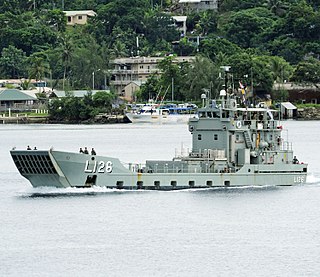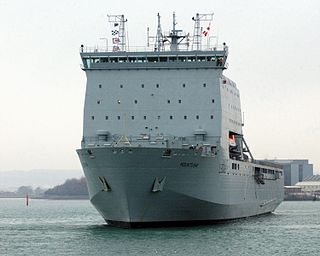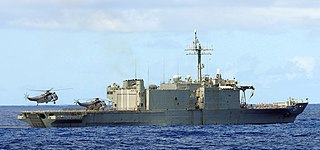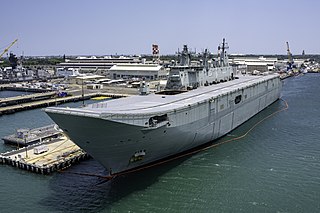
The Royal Australian Navy and Australian Army have operated 29 amphibious warfare ships . These ships have been used to transport Army units and supplies during exercises and operational deployments.

The Royal Australian Navy and Australian Army have operated 29 amphibious warfare ships . These ships have been used to transport Army units and supplies during exercises and operational deployments.

The Australian military's first amphibious warfare ships were the three Landing Ships Infantry (LSI): HMAS Kanimbla, HMAS Manoora, and HMAS Westralia. These three ships had been built as civilian motor vessels and were converted to armed merchant cruisers at the outbreak of war in 1939. They were converted again to LSIs in 1943 and took part in United States and Australian amphibious assaults in the South West Pacific Area. [1] The ships had a capacity of about 1,200 troops, which were landed from boats carried by the LSIs. Following the war, the three LSIs remained in service as transports until 1949 when they were returned to their owners.
The RAN borrowed six Landing Ships Tank (LSTs) from the Royal Navy between 1946 and 1955. [1] The LSTs were used as general purpose vessels and did not specialise in amphibious operations.
Australia was left without any amphibious combat ships after the LSTs were destroyed.. To rectify this situation the Army purchased four LSM-1-class Landing Ships Medium (LSMs) from the United States Navy (USN) in 1959. These ships were operated by the 32nd Small Ship Squadron, Royal Australian Engineers and supported Army exercises and operations. All four of the ships saw active service during the Vietnam War where they carried supplies between Australia and South Vietnam and between South Vietnamese ports. All four ships were decommissioned in September 1971 when the 32nd Small Ship Squadron was disbanded. [2]
The LSMs were replaced by eight Balikpapan-class landing craft heavy which began to enter service in 1971. The first ship in the class, HMAS Balikpapan was briefly operated by the Army's Water Transport force but was later transferred to the Navy and all subsequent ships in the class were transferred to the Navy while they were under construction. [3] These ships proved to be very successful and supported Australian Army exercises and operations throughout South East Asia. Two ships, HMAS Buna and HMAS Salamaua, were transferred to the Papua New Guinea Defence Force in 1974. Three of the remaining craft were decommissioned in December 2012, with the remainder decommissioned in November 2014. [4] [5]

The Australian Defence Force's (ADF's) amphibious warfare capabilities were significantly expanded in 1982 when the landing ship heavy HMAS Tobruk was commissioned. This ship was the first amphibious vessel purpose-built for the RAN and was based on the British Round Table-class landing ship logistics design. She supported ADF operations around the world. [6]

The ADF's amphibious warfare capabilities were further expanded in 1994 when two Newport-class tank landing ships were purchased from the USN. These ships were greatly modified and finally entered service in the late 1990s as the Kanimbla-class landing platform amphibious (LPA). They supported ADF operations in Afghanistan, Iraq, the Solomon Islands and East Timor. [7] Both LPAs were taken out of service in September 2010 due to concerns about their seaworthiness. [8] On 1 February 2011 the Minister for Defence announced that repairing Manoora would not be cost effective given that the ship was scheduled to retired at the end of 2012 and that she would instead be decommissioned. He also stated that Kanimbla would be repaired but was not expected to return to operational service until mid-2012. [9]
In May 2011 the Australian Government chartered the civilian icebreaker Aurora Australis for two months to provide an amphibious capability while Tobruk was undergoing maintenance. [10]
In 2012, the Australian Government purchased the ADV Ocean Shield to provide the RAN with a third ship for humanitarian and disaster relief tasks. Ocean Shield was transferred to the Australian Border Force in July 2014.

In December 2010, a team from the RAN travelled to Britain to inspect the Bay-class landing ship dock RFA Largs Bay, which was scheduled to be placed in reserve in April 2011, and Australian Defence Minister Stephen Smith stated in January 2011 that Australia was considering purchasing the ship. [11] On 6 April 2011 Smith announced that Australia would buy Largs Bay and that the ship was expected to enter service with the RAN in 2012. [12] The vessel was renamed and commissioned as HMAS Choules (L100) in December 2011.

HMAS Tobruk and one of the LPAs were replaced by two Canberra-class landing helicopter docks (LHDs) between 2012 and 2014. These ships are the largest warships ever operated by the Royal Australian Navy, [13] and each is able to carry an infantry battalion and up to 24 Army and Navy helicopters. [14]
In addition to the seagoing ships, the RAN also operates a number of smaller amphibious craft, including four Landing Craft, Vehicle, Personnel (LCVP) which can carry a Land Rover sized vehicle or 36 personnel (deployable from Choules), and 12 LCM-1E mechanized landing craft (deployable from the Canberra-class ships).

HMAS Balikpapan was the lead ship of the Balikpapan class of heavy landing craft (LCH). Ordered in 1969, Balikpapan entered service with the Australian Army Water Transport Squadron in late 1971. After this, the decision to place all seagoing Army vessels under the control of the Royal Australian Navy (RAN) saw Balikpapan transferred and commissioned in 1974; the last of the eight-vessel class to enter RAN service. Balikpapan was placed in reserve in 1985, but was reactivated three years later. During late 1999 and early 2000, the vessel was part of the INTERFET peacekeeping taskforce, and made additional deployments to East Timor in 2001 and 2006. On 12 December 2012, Balikpapan was retired from RAN service.

HMPNGS Buna is a Balikpapan-class heavy landing craft operated by the Papua New Guinea Defence Force (PNGDF). Prior to 1974, the vessel was called HMAS Buna and was operated by the Royal Australian Navy (RAN).

HMAS Choules (L100) is a Bay-class landing ship that served with the Royal Fleet Auxiliary (RFA) from 2006 to 2011, before being purchased by the Royal Australian Navy (RAN). The vessel was built as RFA Largs Bay by Swan Hunter in Wallsend, Tyne and Wear. She was named after Largs Bay in Ayrshire, Scotland, and entered service in November 2006. During her career with the RFA, Largs Bay served as the British ship assigned to patrol the Falkland Islands in 2008, and delivered relief supplies following the 2010 Haiti earthquake.

The Bay class is a ship class of four dock landing ships built for the British Royal Fleet Auxiliary (RFA) during the 2000s. They are based on the Dutch-Spanish Royal Schelde Enforcer design, and replaced the Round Table-class logistics ships. Two ships each were ordered from Swan Hunter and BAE Systems Naval Ships. Construction work started in 2002, but saw major delays and cost overruns, particularly at Swan Hunter's shipyard. In mid-2006, Swan Hunter was stripped of work, and the incomplete second ship was towed to BAE's shipyard for completion. All four ships, Largs Bay, Lyme Bay, Mounts Bay, and Cardigan Bay had entered service by 2007.

HMAS Kanimbla was a Kanimbla-class landing platform amphibious ship operated by the Royal Australian Navy (RAN). Originally built for the United States Navy (USN) as the Newport-class tank landing shipUSS Saginaw (LST-1188), the ship was decommissioned in 1994 and sold to the RAN.

HMAS Kanimbla was a passenger ship converted for use as an armed merchant cruiser and landing ship infantry during World War II. Built during the mid-1930s as the passenger liner MV Kanimbla for McIlwraith, McEacharn & Co, the ship operated in Australian waters until 1939, when she was requisitioned for military service, converted into an armed merchant cruiser, and commissioned in the Royal Navy as HMS Kanimbla.

The Balikpapan class is a ship class of eight heavy landing craft. All eight were originally laid down by Walkers Limited for the Australian Army in the early 1970s. A reorganisation of watercraft responsibilities in the Australian military meant the landing craft were to be operated by the Royal Australian Navy (RAN), with seven commissioned directly into RAN service during 1973 and 1974, and lead ship Balikpapan transferred from the army to the navy. During the leadup to the independence of Papua New Guinea in 1975, two of the vessels were transferred to the new Papua New Guinea Defence Force (PNGDF).

HMAS Manoora was a Kanimbla-class landing platform amphibious ship operated by the Royal Australian Navy (RAN). Originally built for the United States Navy (USN) as the Newport-class tank landing shipUSS Fairfax County (LST-1193), the ship was decommissioned in 1994 and sold to the RAN.

Newport-class tank landing ships were an improved class of tank landing ship (LST) designed for and employed by the United States Navy from 1969 to 2002. The ships were intended to provide substantial advantages over their World War II-era predecessors. Larger and faster than any previous LST design, they carried a ramp over the bow that allowed them to surpass 20 knots, a goal of the United States amphibious forces. 27 were planned of which twenty were completed, the high number due to the demands of US force projection estimates. However, the arrival of the air-cushioned landing craft which allowed for over-the-horizon attacks made the class obsolete in the eyes of the United States Navy. Placed in reserve, twelve were eventually sold to foreign navies, while the remaining eight have since been decommissioned.
The Royal Australian Navy, although a significant force in the Asia-Pacific region, is nonetheless classed as a medium-sized navy. Its fleet is based around two main types of surface combatant, with limited global deployment and air power capability. However, in 2009, a white paper, Defending Australia in the Asia Pacific Century: Force 2030, was produced by the Australian government which set out a programme of defence spending that will see significant improvements to the RAN's fleet and capabilities.

The Kanimbla class was a class of amphibious transport ships operated by the Royal Australian Navy (RAN). Two ships were purchased by Australia in 1994 and modified. Problems during the handover process and the need to repair previously unidentified defects meant the ships did not enter operational service until the end of the decade.

The Canberra class is a ship class of two landing helicopter dock (LHD) ships built for the Royal Australian Navy (RAN). Planning to upgrade the navy's amphibious fleet began in 2000, based on Australian experiences leading the International Force for East Timor peacekeeping operation. With a new climate for growing Australian Navy spending, a desire existed for forward defence capability for landing and supporting troops on Asian territory, that had never existed in Australian history, even with the old Majestic-class light fleet carriers, HMAS Melbourne and HMAS Sydney in the 1970s. In 2004, French company Direction des Constructions Navales (DCN) and Spanish company Navantia were invited to tender proposals, with DCN offering the Mistral-class amphibious assault ship and Navantia proposing the "Buque de Proyección Estratégica" design. The Spanish design was selected in 2007, with Navantia responsible for construction of the ships from the keel to the flight deck, and BAE Systems Australia handling the fabrication of the combat and communications systems. Finally, Siemens (Germany) supplied and fitted the azimuth thrusters.

A landing ship, infantry (LSI) or infantry landing ship was one of a number of types of British Commonwealth vessels used to transport landing craft and troops engaged in amphibious warfare during the Second World War. LSIs were operated by the Royal Navy, British Merchant Navy, Royal Canadian Navy, Royal Indian Navy, and Royal Australian Navy. They transported British Commonwealth and other Allied troops in sea assaults and invasions throughout the war.

HMAS Tobruk was a Landing Ship Heavy (LSH) of the Royal Australian Navy (RAN), based on the design of the Round Table-class of the British Royal Fleet Auxiliary. Planning for the ship began in the 1970s to provide the Australian Army with a permanent sealift capability. She was laid down by Carrington Slipways in 1979, launched in 1980, and commissioned in 1981. She was a multi-purpose, roll-on/roll-off heavy lift ship capable of transporting soldiers, APCs, and tanks, and delivering them to shore via landing craft or directly by beaching.

HMAS Wewak was the fifth ship of the Balikpapan class of heavy landing craft operated by the Royal Australian Navy (RAN).
The LCM2000 was a class of Landing Craft Mechanised (LCM) built for the Australian Army by Australian Defence Industries (ADI). The LCMs were ordered in 2001 and the first craft was originally scheduled to enter service with the Army in 2003. The craft proved too large for their intended purpose, however, and were only used for training and minor exercises before the project was cancelled in February 2011.

BRP Ivatan (LC-298) is a Balikpapan-class heavy landing craft operated by the Philippine Navy. One of eight vessels built by Walkers Limited for the Royal Australian Navy (RAN), the ship was commissioned into Australian service in 1973 as HMAS Brunei. During her RAN career, Brunei visited Lord Howe Island, was deployed post-Cyclone Tracy as part of Operation Navy Help Darwin, performed coastal surveys of northern Australia and Papua New Guinea, and served as part of the INTERFET peacekeeping taskforce.